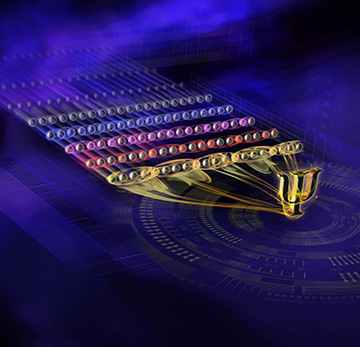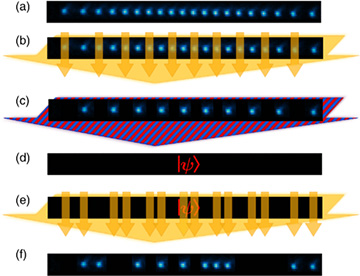
In an experiment involving a linear array of ions, the IQOQI Innsbruck team tracked the evolution of entanglement as the system evolved in time. [Image: IQOQI Innsbruck/Harald Ritsch]
Using a system of 20 trapped calcium ions, physicists in Austria have demonstrated what they describe as the largest register of entangled, individually controllable quantum bits (qubits) shown to date (Phys. Rev. X, doi: 10.1103/PhysRevX.8.021012). The team was able both to encode a complex initial state in the 20-ion ensemble and to demonstrate entanglement among those individual qubits at various stages of the system’s evolution. Moreover, by using both analytical and numerical “entanglement witnesses” developed in the work, the team found that it could detect not only entanglement among pairs of neighboring ions, but “genuine multipartite entanglement” among neighboring groups of three, four and even five ions.
The result, according to Ben Lanyon, a co-leader of the research at the Institute of Quantum Optics and Quantum Information (IQOQI), Innsbruck, provides evidence that ion-based quantum simulators—which some view as a way station on the road to full-fledged quantum computers—do indeed provide a window into otherwise inscrutable quantum behavior. “We’re building confidence,” he says, “that we are accessing complex quantum states” in these simulators.
Toward individual control
Quantum simulators use systems of atoms, ions or other qubits to model quantum behavior beyond the abilities of classical computing algorithms. They’ve come a long way in the past year, with several groups successfully building simulators involving 50 or more qubits. But Lanyon says these experiments with larger ensembles haven’t yet demonstrated the level of control of each individual particle in the system, and of particle entanglement, shown in the 20-qubit Innsbruck experiments.
To achieve that control, the IQOQI team employed a radio-frequency Paul trap to set up a register of 20 calcium ions in a linear array. Next, the researchers used laser fields to flip every second qubit, setting up a specific initial Hamiltonian, or energy state, for the system. They then quenched the system at various time steps, and used quantum-state-dependent resonance fluorescence imaging, via a single-ion-resolving CCD camera, to measure the state of each qubit.

In the experiment, the Austrian group (a) captured an array of 20 ions in Paul trap, (b and c) used laser fields to initialize the ions, (d) allowed the system to evolve in time to an unknown quantum state, and then (e and f) quenched the evolution and used resonance fluorescence imaging to read out the quantum state of each qubit. [Image: N. Friis et al., “Observation of entangled states of a fully controlled 20-qubit system,” Phys. Rev. X, doi: 10.1103/PhysRevX.8.021012]
From twins to quintuplets
The IQOQI team next dug into measuring the level of entanglement among the qubits. Estimating the full quantum state density matrix for the 20-qubit ensemble would have required assessing billions of measurement bases. So the researchers focused on the set of bases required to reconstruct the density matrices of all neighboring 3-quibit groups in the linear array—a much more tractable problem involving only 27 bases.
Using those density matrices, and a parameter called the genuine multipartite negativity, they were able to establish that all adjacent pairs of the linear array became entangled very quickly as the system evolved. But what about multipartite entanglement, among larger numbers of qubits? To assess that, Lanyon and his co-lead investigator, Rainer Blatt, turned for help to two groups of theorists, Marcus Huber’s team at IQOQI’s Vienna branch, and Martin Plenio’s research group at the University of Ulm, Germany.
The theoretical groups devised two complementary entanglement witnesses that could be used to establish higher orders of entanglement. Huber’s group offered a relatively simple, analytical method that was effective at inferring entangled triplets from the two-qubit observables already established by the Innsbruck team. For detecting multipartite entanglement among collections of four and five qubits, Plenio’s team provided a computationally intense, “brute force” numerical search technique.
Putting all of the techniques together, the Innsbruck team was able to establish that adjacent pairs of particles in the linear system quickly became entangled, and that quantum correlations built up among triplets, most quadruplets and some quintuplets as the system evolved in time.
Accessing true quantum behavior
Establishing multipartite entanglement for groups of more than five qubits outstripped the computational power that the team could bring to bear, and “remains an open challenge,” according to the paper. But even that five-qubit limit, according to Lanyon, might be a feature rather than a bug, since it underscores that the simulator is indeed demonstrating quantum behavior beyond the reach of classical algorithms.
“What we’re interested in doing with these controlled quantum simulators is accessing quantum dynamics that we can’t otherwise access using conventional means,” says Lanyon. “So we’re kind of encouraged that we’re seeing this behavior—that our simulator goes beyond the point where we can follow it with existing methods at the moment.” As simulator systems become larger and larger, he maintains, it’s important to have methods to verify that the simulator is “behaving the way we think it is”; verifying lower-order entanglement is one way to “get feedback in the lab that we’re doing the right thing.”
Meanwhile, Lanyon notes that while the techniques don’t scale well in order of entanglement, they do scale efficiently in system size. That opens up the prospect for practical simulators involving hundreds or even thousands of particles. And the paper concludes that the ability to individually control qubit–qubit interactions means that the system “has the capability to perform universal quantum simulation and quantum computation.”
